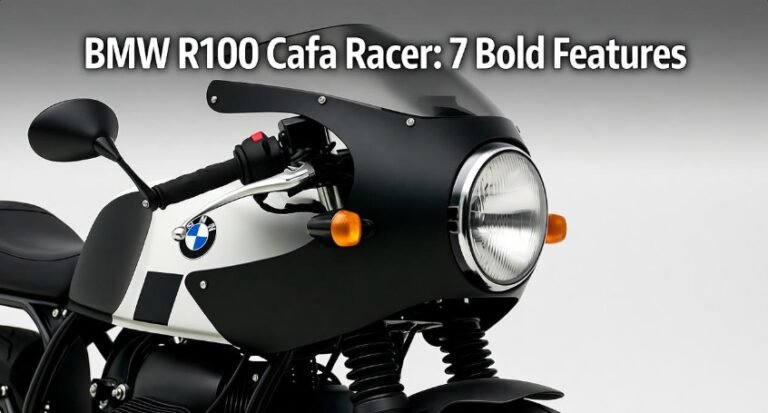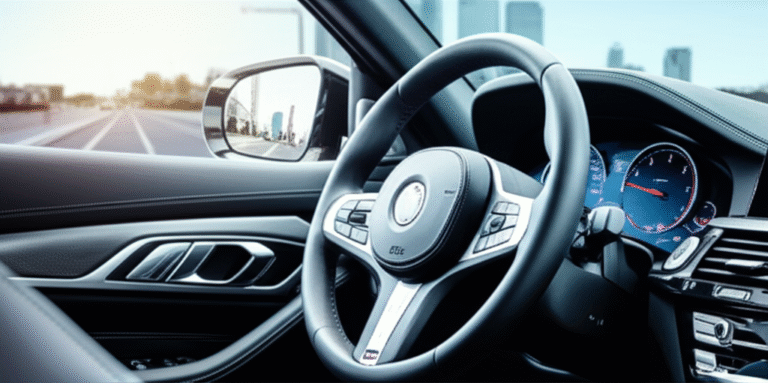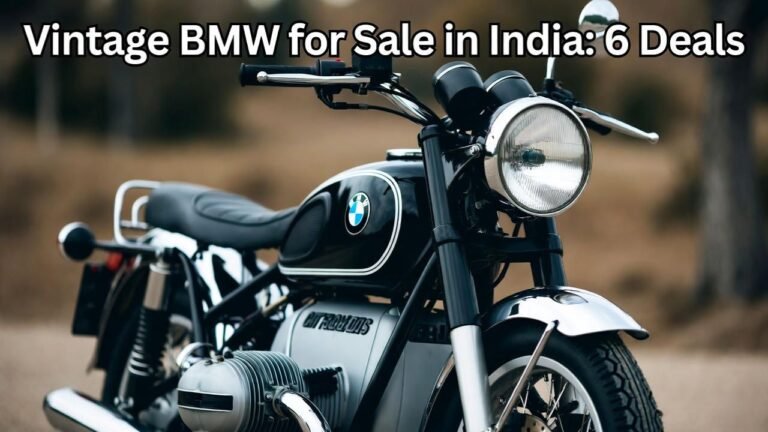Which is Best Mercedes or BMW: 7 Bold Comparison Facts
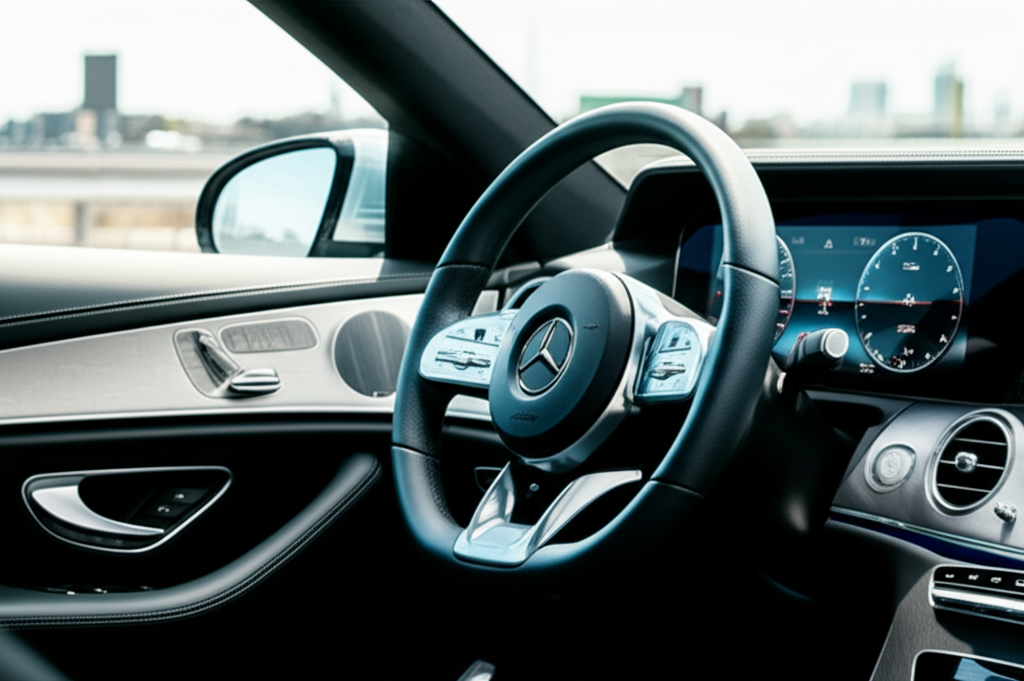
Deciding between a Mercedes-Benz and a BMW is a classic luxury car dilemma. Both German titans offer exceptional engineering and performance, but “which is best Mercedes or BMW” depends on your priorities. Mercedes often leads in comfort and refined luxury, while BMW excels in sporty driving dynamics and driver engagement.
Key Takeaways
- Understand Mercedes’ focus on luxurious comfort.
- Recognize BMW’s emphasis on agile performance.
- Compare interior design philosophies for sophistication.
- Evaluate technology integration for user experience.
- Consider powertrain differences for your driving style.
- Explore brand reputation and resale value trends.
- Factor in maintenance costs and service networks.
Choosing a luxury car in the USA can feel like navigating a grand gallery. Among the most iconic exhibits are Mercedes-Benz and BMW. For decades, these German automakers have set benchmarks for automotive excellence, making the question, “Which is best Mercedes or BMW,” a frequent, and often passionate, debate among enthusiasts and everyday drivers alike. You might be drawn to the serene elegance of a Mercedes or the dynamic spirit of a BMW. Both offer cutting-edge technology, premium comfort, and thrilling performance. But they achieve these qualities through different approaches. This guide breaks down seven key comparison facts to help you confidently decide which brand truly aligns with your driving desires and lifestyle in the USA.
1. Driving Dynamics: Comfort vs. Sportiness
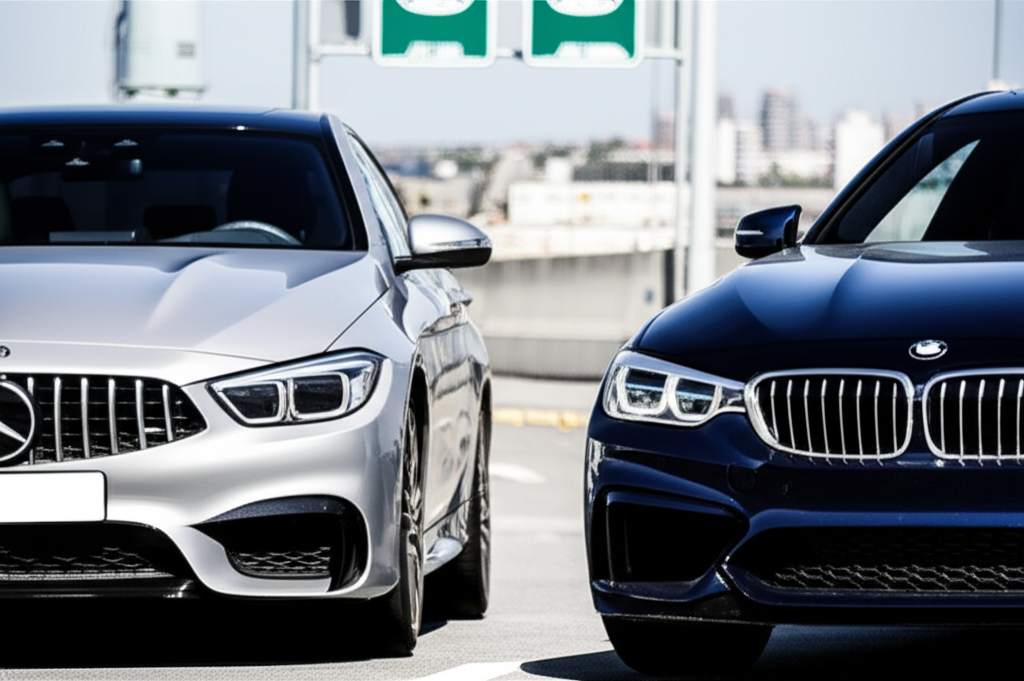
One of the most significant differentiators between Mercedes-Benz and BMW lies in their fundamental approach to driving dynamics. For a long time, Mercedes-Benz has cultivated a reputation for delivering a supremely comfortable and refined ride. Think of gliding effortlessly down a highway in the USA, insulated from road noise and imperfections. This is the Mercedes promise: a sanctuary on wheels, prioritizing passenger well-being and a sense of serene luxury. Their suspension systems are often tuned to absorb bumps and provide a smooth, stable presence, making long journeys an absolute pleasure.
BMW, on the other hand, has built its brand identity around the concept of the “ultimate driving machine.” This means a more direct, engaging, and sporty driving experience. When you get behind the wheel of a BMW, you’re likely to feel a more connected-to-the-road sensation. The steering is typically sharper, the chassis more responsive, and the overall feel is geared towards enthusiastic driving. This doesn’t mean BMWs are uncomfortable; they’ve made huge strides in balancing sportiness with daily usability. However, if your priority is feeling every subtle nuance of the road and enjoying agile handling through winding routes, a BMW often has the edge.
To illustrate this, let’s consider how their core models typically perform:
| Brand | Primary Focus | Typical Feel | Best For |
|---|---|---|---|
| Mercedes-Benz | Comfort, Refinement, Serenity | Smooth, Stable, Insulated | Long commutes, relaxed cruising, luxury touring |
| BMW | Sportiness, Agility, Driver Engagement | Responsive, Connected, Dynamic | Enthusiastic driving, spirited commutes, twisty roads |
For drivers in the USA, this distinction can be crucial. If your daily drive involves navigating busy city streets or traversing vast distances across states, the comfort-focused approach of Mercedes might be more appealing. If, however, you relish the journey itself and enjoy a more dynamic, connected driving experience, BMW might be your preferred choice. It’s not about one being objectively “better,” but about which philosophy aligns with how you want to feel when you’re driving.
2. Interior Design and Luxury: Elegance vs. Driver-Centric
Stepping inside a Mercedes-Benz and a BMW is an experience in contrasting luxury philosophies. Mercedes-Benz interiors are often characterized by their opulence, exquisite materials, and a sense of flowing elegance. They aim to create an environment that feels like a sophisticated lounge or a high-end retreat. You’ll often find lavish wood trims, premium leathers, ambient lighting that can be customized to create a specific mood, and a general aesthetic that whispers luxury rather than shouts it. The integration of technology, while advanced, is often seamlessly blended into the cabin’s design, creating a cohesive and visually pleasing experience.
BMW interiors, while undoubtedly luxurious and premium, tend to be more driver-centric and functional. The design language often emphasizes clean lines, ergonomic excellence, and a layout that places the driver at the heart of the experience. Controls are typically intuitive and easily accessible, reflecting BMW’s performance heritage. While BMWs also use high-quality materials and offer sophisticated technology, the overall impression is often one of purposeful refinement and performance-oriented design. It’s a cockpit built for driving, but with all the premium touches you’d expect from a luxury marque.
Consider these interior characteristics:
- Mercedes-Benz: Opulent finishes, ambient lighting, flowing dashboard design, emphasis on passenger comfort and serene atmosphere.
- BMW: Driver-focused cockpit, logical layout, ergonomic controls, sporty accents, emphasis on performance and intuitive operation.
When you’re spending significant time in your vehicle, especially during your commutes or road trips across the USA, the interior environment plays a massive role in your overall satisfaction. Do you prefer an environment that feels like a luxurious sanctuary, or one that feels like a precision instrument designed around you? Both brands offer exceptional quality, but their design intentions cater to different tastes and priorities.
3. Powertrain Options: Smooth Power vs. Responsive Engines
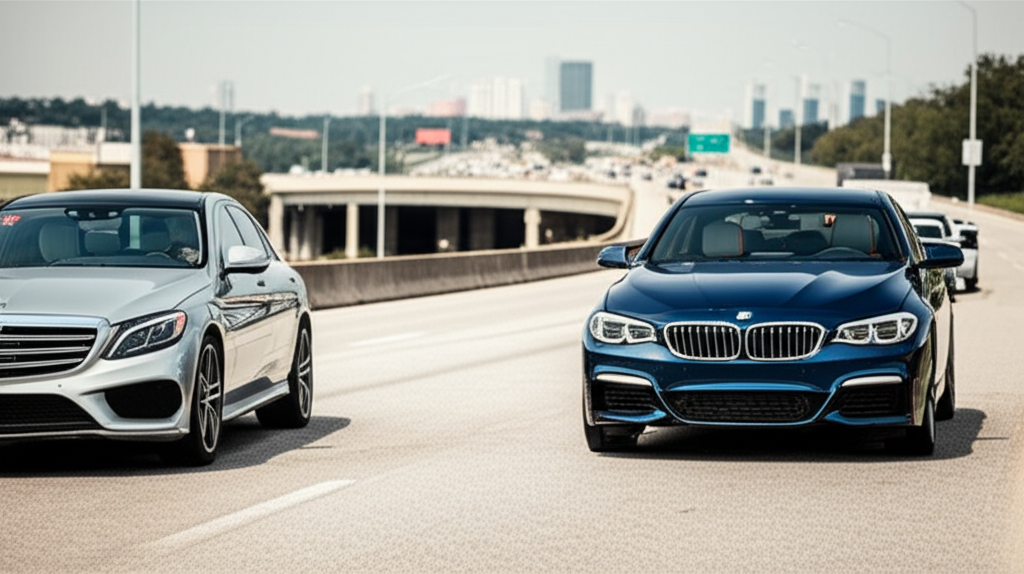
The heart of any car is its engine, and both Mercedes-Benz and BMW offer a wide array of powerful and sophisticated powertrains. However, their tuning and character often reflect their brand philosophies. Mercedes-Benz powertrains, particularly in their more comfort-oriented models, tend to deliver power in a smooth, linear, and refined manner. Acceleration feels effortless, with gear shifts often imperceptible. This contributes to the serene and luxurious driving experience. Even their performance divisions, like AMG, offer immense power, but often with a focus on delivering it in a way that’s still manageable and comfortable for daily driving, albeit at a much higher intensity.
BMW’s engines are renowned for their responsiveness and their engaging character. Whether it’s a turbocharged four-cylinder or a potent inline-six, BMW engines often feel eager to rev and provide a more immediate connection to the throttle. The power delivery is typically more direct, and the transmission tuning is geared towards providing quick shifts and maintaining the engine in its optimal power band, especially in their sportier modes. This contributes significantly to BMW’s reputation for dynamic performance and driver enjoyment. Many enthusiasts in the USA specifically seek out BMW’s inline-six engines for their smooth power delivery and characteristic growl.
Here’s a simplified comparison:
| Brand | Power Delivery | Transmission Tuning | Engine Character |
|---|---|---|---|
| Mercedes-Benz | Smooth, Linear, Effortless | Refined, Comfort-focused shifts | Calm, Powerful, Serene |
| BMW | Responsive, Direct, Eager | Sporty, Quick shifts, Performance-oriented | Engaging, Nimble, Dynamic |
When you consider your driving needs in the USA, think about how you want your car to respond when you press the accelerator. Do you prefer a surge of smooth, refined power, or a more immediate and sporty response that makes you feel more connected to the car’s capabilities? This is a key area where the brands diverge and cater to different driving preferences.
4. Technology and Infotainment Systems: User Experience
Both Mercedes-Benz and BMW are at the forefront of automotive technology, constantly innovating to offer drivers the latest in connectivity, safety, and convenience. The way they integrate this technology, however, can differ. Mercedes-Benz often employs a dual-screen setup, with one screen serving as the instrument cluster and another for the infotainment system, often under a sleek glass panel. Their MBUX (Mercedes-Benz User Experience) system is known for its natural voice control (“Hey Mercedes”) and its visually rich interface, designed to be intuitive and luxurious. The focus is on creating a sophisticated digital environment that enhances the cabin’s premium feel.
BMW’s iDrive system has long been a benchmark for usability and driver focus. While it has evolved to include touchscreens and voice commands, it often retains a physical rotary dial controller on the center console. This allows drivers to navigate menus and make selections without taking their eyes off the road for too long, a feature highly valued by those who prioritize a distraction-free driving experience. BMW’s interface is generally considered very logical and easy to master, with crisp graphics and quick response times. Their integration of features like Apple CarPlay and Android Auto is also typically seamless.
Let’s look at their tech approaches:
- Mercedes-Benz MBUX: Visually stunning displays, advanced voice control, seamless integration, focus on luxury interface.
- BMW iDrive: Driver-centric controls (rotary dial), intuitive menus, quick response, emphasis on ease of use while driving.
Consider how you prefer to interact with your car’s technology. Do you enjoy a highly visual, voice-command-driven experience, or do you prefer tactile controls and a system that feels designed to minimize distraction? Exploring these systems firsthand at a dealership in the USA can be very revealing. Both brands offer cutting-edge safety features, often including advanced driver-assistance systems (ADAS) that can make driving safer on American roads, such as adaptive cruise control and lane-keeping assist.
5. Performance Models and M vs. AMG
For enthusiasts who crave thrilling performance, both Mercedes-Benz and BMW offer dedicated performance divisions that push the boundaries of automotive engineering. Mercedes-AMG and BMW M GmbH are legendary for transforming their standard models into track-ready machines. When comparing “Which is best Mercedes or BMW” for outright performance, it’s often a case of nuanced differences.
Mercedes-AMG models are known for their monstrous power, often featuring hand-built engines and a blend of brute force with surprisingly sophisticated handling. They deliver incredible acceleration and a visceral driving experience, but often retain a degree of the signature Mercedes comfort, albeit a very firm and capable version of it. AMG cars feel like powerful luxury GTs that can also dominate a racetrack.
BMW M cars are traditionally built with a more purist, track-focused ethos. They emphasize chassis dynamics, precise steering, and a finely tuned balance between power and handling. The goal is often to provide driver feedback and agility that makes them incredibly rewarding to drive hard on a circuit. While they are undeniably powerful and luxurious, the primary focus remains on the driving engagement and the connection between driver, car, and road.
Here’s a brief look at their performance icons:
| Brand | Performance Division | Key Focus | Notable Models |
|---|---|---|---|
| Mercedes-Benz | AMG | Brute Force, Luxury GT Performance, Sound | C63 AMG, E63 AMG, GT AMG |
| BMW | M | Agile Handling, Driver Connection, Track Prowess | M3, M4, M5, M8 |
Whether you’re looking for a thrilling daily driver or a weekend track weapon in the USA, both AMG and M offer incredible options. Your preference might come down to whether you favor raw, thunderous power delivered with a luxurious flourish (AMG) or razor-sharp handling and an intimate driving connection (M).
6. Brand Reputation and Resale Value
Both Mercedes-Benz and BMW enjoy stellar global reputations for engineering, innovation, and luxury. They are instantly recognizable symbols of success and automotive sophistication. In the USA, owning either brand often signifies a certain status and appreciation for quality. When it comes to brand perception, it’s largely a matter of personal taste and the specific image you associate with each marque. Mercedes-Benz is often perceived as the epitome of ultimate luxury, prestige, and advanced comfort, while BMW is seen as the choice for those who prioritize performance and dynamic driving prowess.
Resale value is another important consideration for car owners in the USA. Historically, both brands have held their value well, especially for their most desirable models. However, depreciation is a factor for all luxury vehicles. Factors influencing resale value include model popularity, maintenance history, mileage, and overall market demand. In general, well-maintained examples of popular models from both Mercedes-Benz and BMW tend to perform favorably. It’s always wise to research the specific models you’re interested in, as certain variants or generations might hold their value better than others. Resources like Kelley Blue Book (KBB) or Edmunds can provide insights into projected resale values for specific vehicles in the U.S. market.
When considering brand perception and resale:
- Mercedes-Benz: Perceived as ultimate luxury, prestige, and innovation. Generally strong resale value.
- BMW: Perceived as sporty, driver-focused, and performance-oriented. Also exhibits strong resale value.
While both brands are strong, sometimes one might have a slight edge in perceived prestige or a particular model might be more sought after on the used market. This is an area where a bit of research into current trends in the USA automotive scene can be beneficial.
7. Cost of Ownership and Maintenance
Luxury vehicles, by their nature, come with a higher cost of ownership compared to mainstream brands. This includes purchase price, insurance, and, crucially, maintenance and repair costs. Both Mercedes-Benz and BMW vehicles utilize complex engineering and high-quality components, which can translate to more expensive parts and specialized labor for upkeep. Generally, you can expect maintenance costs for both brands to be above average.
Historically, some analyses have suggested that BMW maintenance and repair costs can occasionally edge higher than Mercedes-Benz, particularly out of warranty. However, this can vary significantly by model, model year, and the specific repair needed. The availability of qualified technicians and dealerships across the USA is excellent for both brands, ensuring you can find service. However, the cost for routine services like oil changes, brake jobs, or more significant repairs can add up. It’s always a good idea to factor in an extended warranty or service package when purchasing, especially if you plan to keep the car for an extended period beyond its initial warranty.
Here’s a general outlook on ownership costs:
| Aspect | Mercedes-Benz | BMW | Notes |
|---|---|---|---|
| Purchase Price | Premium | Premium | Both are luxury brands. |
| Insurance | Higher than mainstream | Higher than mainstream | Varies by model and driver profile. |
| Maintenance & Repair | Above average, potentially less than BMW | Above average, potentially more than Mercedes | Specialized parts and labor. Consider service packages. |
| Fuel Efficiency | Varies by model, improving | Varies by model, improving | Hybrid and EV options available for both. |
When making your decision in the USA, it’s wise to get quotes for insurance on specific models you’re considering. Also, research typical maintenance schedules and potential costs for those models. Many owners find that the ownership experience, including the advanced features and driving pleasure, justifies the investment. If long-term cost is a primary concern, researching models known for reliability and lower maintenance burden within each brand is recommended.
Pro Tip: Before purchasing, look into the brand’s certified pre-owned (CPO) programs. They often include extended warranties and thorough inspections, offering peace of mind for ownership costs.
FAQ: Mercedes vs. BMW
Q1: Which brand is more reliable: Mercedes or BMW?
A1: Both brands offer advanced engineering, and reliability can vary by specific model and year. Historically, neither has consistently outperformed the other across the board. Regular maintenance is key for both.
Q2: Is it better to buy a Mercedes or a BMW for city driving in the USA?
A2: For city driving, both are excellent. If you prioritize a smoother, more comfortable ride through traffic, Mercedes might have a slight edge. If you prefer a more nimble and engaging feel for navigating tighter spaces and traffic, BMW excels.
Q3: Which brand offers better fuel economy?
A3: Fuel economy varies greatly by model and engine. Both brands offer efficient compact cars, hybrids, and fully electric vehicles (EVs). It’s best to compare specific models you are interested in.
Q4: Are Mercedes or BMW cars more expensive to maintain in the USA?
A4: Both are premium brands with higher maintenance costs than non-luxury cars. While it can vary, BMWs are sometimes cited as having slightly higher repair costs out of warranty compared to Mercedes-Benz, but this is not a universal rule.
Q5: Which brand is better for families: Mercedes or BMW?
A5: Both offer compelling family vehicles like SUVs and sedans. Mercedes often emphasizes passenger comfort and luxurious interiors, making them feel very premium for families. BMW offers excellent practicality and a more engaging drive for parents.
Q6: Is a Mercedes or BMW better for long road trips across the USA?
A6: Mercedes-Benz is often praised for its superior comfort, quiet cabin, and plush ride, making it an ideal choice for long-distance cruising. BMWs are also very capable on long trips and offer a more driver-focused experience.
Q7: Which brand is considered more prestigious?
A7: Prestige is subjective. Mercedes-Benz is widely perceived as embodying ultimate luxury and prestige. BMW is seen as prestigious due to its performance heritage and status as a premium, driver-oriented brand. Both are highly respected.
Conclusion
Ultimately, the question of “Which is best Mercedes or BMW” doesn’t have a single right answer. Both automotive giants produce exceptional vehicles that cater to discerning drivers across the USA. Mercedes-Benz leans towards refined luxury, unparalleled comfort, and a serene driving environment. BMW champions dynamic performance, engaging handling, and a driver-centric cockpit. Your personal preference for ride quality, interior ambiance, and driving engagement will be the deciding factor. We encourage you to test drive models from both brands, explore their technology features, and consider your lifestyle needs. Whichever you choose, you’ll be investing in a piece of German automotive excellence.

